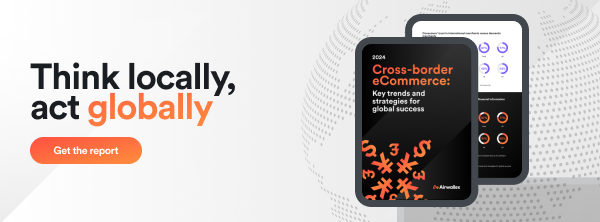How to navigate common business challenges when expanding internationally

Annette Rowena
Author

The global cross-border eCommerce market is expected to soar to US$7.9 trillion by 2030, offering merchants an unprecedented opportunity to boost their revenue streams by venturing beyond local markets. Yet challenges like payment compliance and security and customer experience loom large. With the right approach, businesses like yours can overcome these hurdles and realise global eCommerce success.
In this article, you'll learn about the five common challenges businesses face with insights derived from our latest global eCommerce whitepaper, “Cross-border eCommerce: Key trends and strategies for global success in 2024.” Learn how to navigate them effectively when going global and supercharge your business growth.
Challenge #1: Regulatory and compliance requirements
As your business goes global, it must adhere to regulations and laws that set and govern best practices for payments. This may include standard practices around facilitating transactions, the storing of payment data and monitoring for fraud. What makes things more complicated is that these requirements differ by country. A solid understanding can help you avoid risks such as customer data breaches and the legal penalties that may result from that.
How to navigate this challenge
Prioritising compliance, payment regulations and other relevant regulations specific to the market you’re entering is crucial. Apart from Payment Card Industry Data Security Standard (PCI DSS), a global compliance standard for payments, businesses will need to follow local Data Privacy laws when collecting, storing and using customers’ personal information. It may be prudent to leverage the expertise of a payment service provider that offers streamlined solutions for meeting global and local compliance standards for payments. This will enable you to concentrate on your core business operations while remaining locally compliant.
Challenge #2: Cultural and language differences and how they impact marketing and customer engagement
International marketing is complex and requires a country-specific approach. It's crucial to understand and respect the different cultural nuances of markets worldwide. For instance, to succeed in China, strategies might include leveraging popular platforms like TikTok and WeChat for marketing and customer service, adapting to local payment methods such as Alipay and WeChat Pay, and ensuring your marketing messages resonate with Chinese values and trends. This level of customisation can make a significant positive impact and truly connect with Chinese consumers.
How to navigate this challenge
Using social platforms and crafting promotional content tailored to specific languages can bridge cultural gaps, build trust, and cultivate a worldwide community of devoted customers. Working with local experts can also provide valuable insights into the cultural norms and preferences of your target audience. This could involve partnering with local influencers or hiring a team to better understand consumer behaviour and develop effective marketing strategies. Interestingly, our whitepaper reveals that endorsements from global influencers and content creators significantly influence consumer trust in foreign merchants, product discovery, and their overall purchasing decisions too.
Challenge #3: Payment solutions and currency exchange considerations
As a new entrant in the international eCommerce market, your business may face challenges related to collecting different currencies in customer’s preferred payment methods. While not doing business in your customer’s local currency can place you at a disadvantage against your competitors, fluctuating currency values pose a big risk to your business’s profits.
Addressing this challenge is crucial. Our research indicates that 93% of global consumers say that seeing products priced in their local currency influences their buying decisions. Furthermore, up to 77% would abandon their shopping carts if they couldn't use their preferred payment method at checkout.
How to navigate this challenge
To succeed in the global market, your business needs to adapt by offering a variety of payment options tailored to different regions, with a focus on security and convenience. Consider working with a payment provider that provides the same geographical span as your business. Your provider allows you to manage cross-border transactions with ease and confidence.
Challenge #4: Logistics complexities in cross-border shipping and distribution
Efficient logistics management is a key challenge for businesses that depend on smooth shipping and fulfilment operations across different countries. Dealing with transportation costs, customs processes, and different shipping times are big obstacles that need smart solutions. In our report, 47% of consumers say that lengthy refunding processing times present a challenge when shopping online from an international merchant. This highlights the importance of addressing delivery challenges and improving distribution networks, which are vital for satisfying international customers and keeping operational costs under control. Managing payments to vendors in different countries, especially when dealing with large and frequent transactions, adds complexity to the logistical challenges businesses already face.
How to navigate this challenge
First, to effectively handle complex logistics, our whitepaper indicates that businesses can work with third-party logistics providers to build strong eCommerce supply chains and make international shipping smoother. Partnering with the right experts helps businesses manage international customs, deal with taxes, use local fulfilment centres for better inventory control, and streamline return processes. By adopting these strategies, your business can become more agile, save money, and improve customer satisfaction.
Next, to handle the delicate balance of international payments efficiently and accurately, businesses need a well-integrated approach like the ability to hold balances in multi-currency accounts and bill payments that fits smoothly into their wider logistics operations. This can help simplify payment processes, strengthen relationships with vendors, and improve overall supply chain management effectiveness.
Challenge #5: Harnessing the ‘impulse purchase’ market
In today's fast-paced world, the ability to capture the fleeting attention of global consumers and convert it into a purchase is invaluable. Social media plays a pivotal role in enabling impulsive buying, particularly across borders. Social media platforms streamline the journey from product discovery to purchase, addressing customer queries and fostering community connections along the way. Its strength lies in guiding consumers smoothly through the buying process, encouraged by engaging content and interactive experiences, which often leads to impulsive purchases. How do you effectively tap into this ‘impulse purchase’ market though?
How to navigate this challenge
Our whitepaper indicates that merchants can leverage modern payments technology by integrating payment links into their social media channels to capitalise on the impulsive nature of international consumers. By providing a seamless and secure payment experience, businesses can increase the likelihood of international buyers clicking payment links and making on-the-spot purchases.
Embracing success in cross-border eCommerce
In the age of digitisation, businesses are not confined by geographical boundaries but are empowered to reach consumers across the globe. By staying informed, being adaptable, and leveraging technology, you can be at the forefront of the global enterprise revolution. Future-proofing your business with tailored solutions, such as those offered by Airwallex, will pave the way for seamless international endeavours, allowing you to capture the hearts and wallets of a global customer base.
Find more insights from our latest whitepaper
As your business aims for international growth, it's important to stay updated with global trends, regulatory updates, and new market developments. Discover more insights from our "Cross-border eCommerce: Key trends and strategies for global success in 2024" whitepaper, including how emerging technologies and shifting consumer behaviours are driving cross-border eCommerce and how to leverage these trends to win and retain customers.


Annette Rowena
Author
Annette Rowena is a seasoned writer who uses financial knowledge and engaging storytelling to simplify complex fintech topics.
Posted in:
Business bankingShare
- Challenge #1: Regulatory and compliance requirements
- Challenge #2: Cultural and language differences and how they impact marketing and customer engagement
- Challenge #3: Payment solutions and currency exchange considerations
- Challenge #4: Logistics complexities in cross-border shipping and distribution
- Challenge #5: Harnessing the ‘impulse purchase’ market
- Embracing success in cross-border eCommerce
- Find more insights from our latest whitepaper


